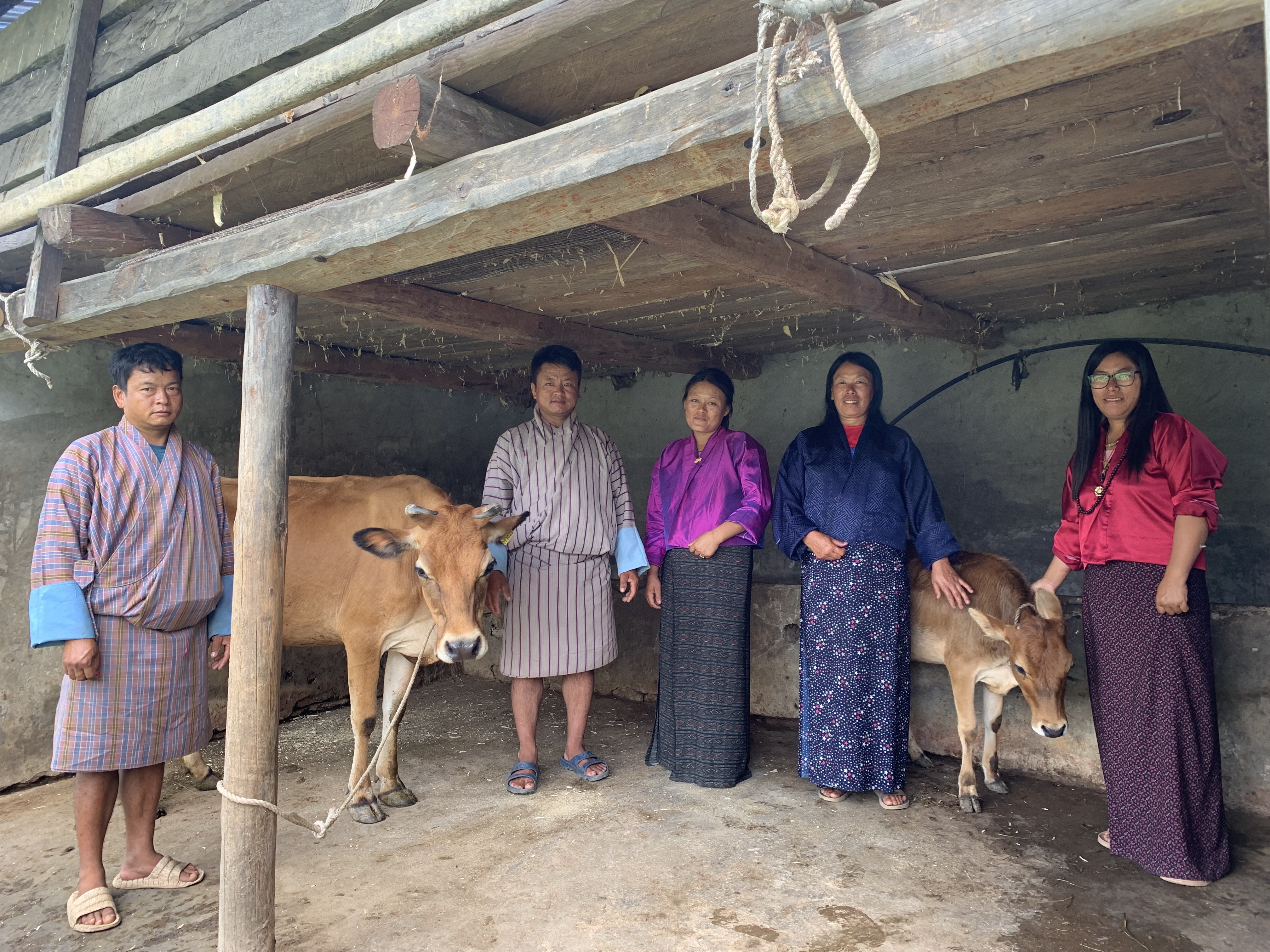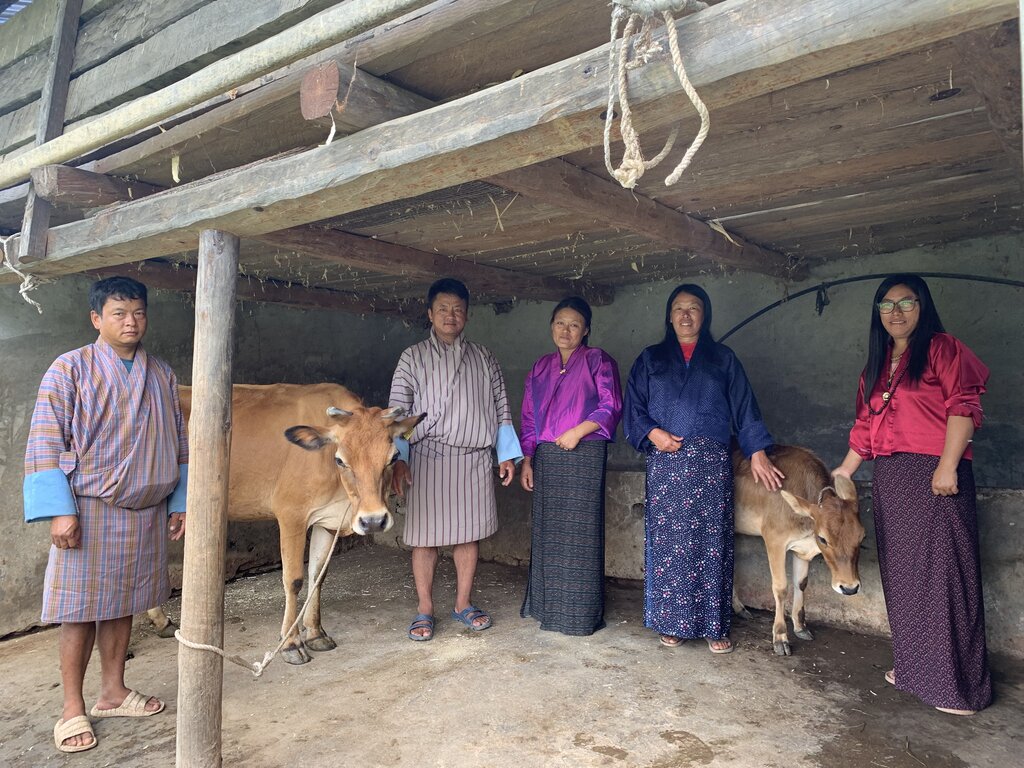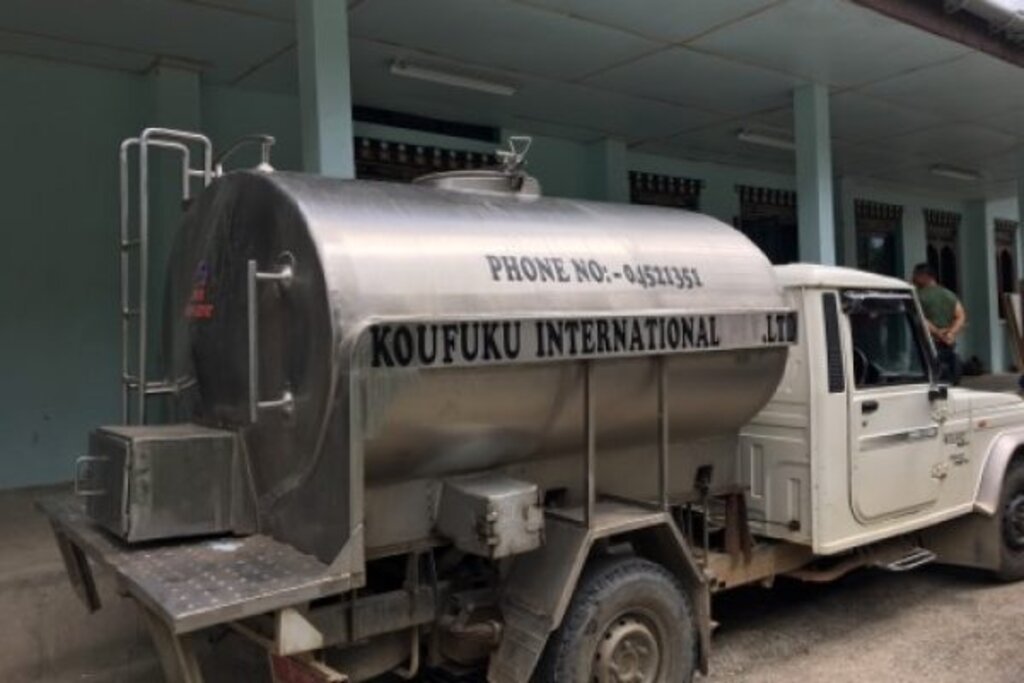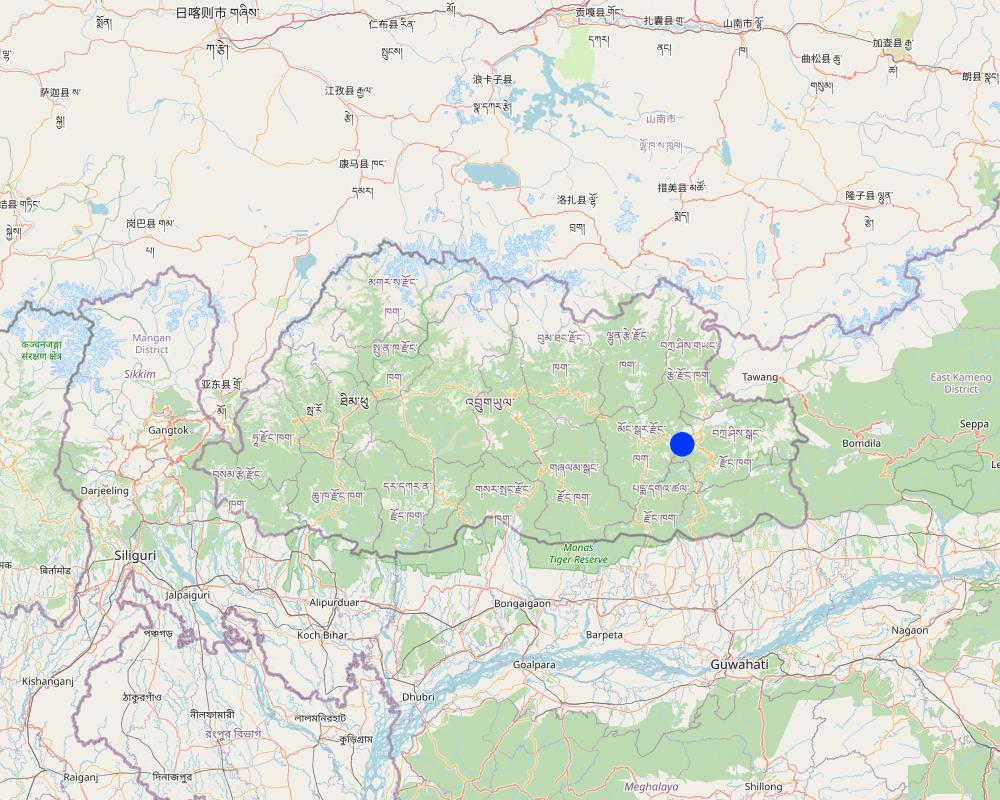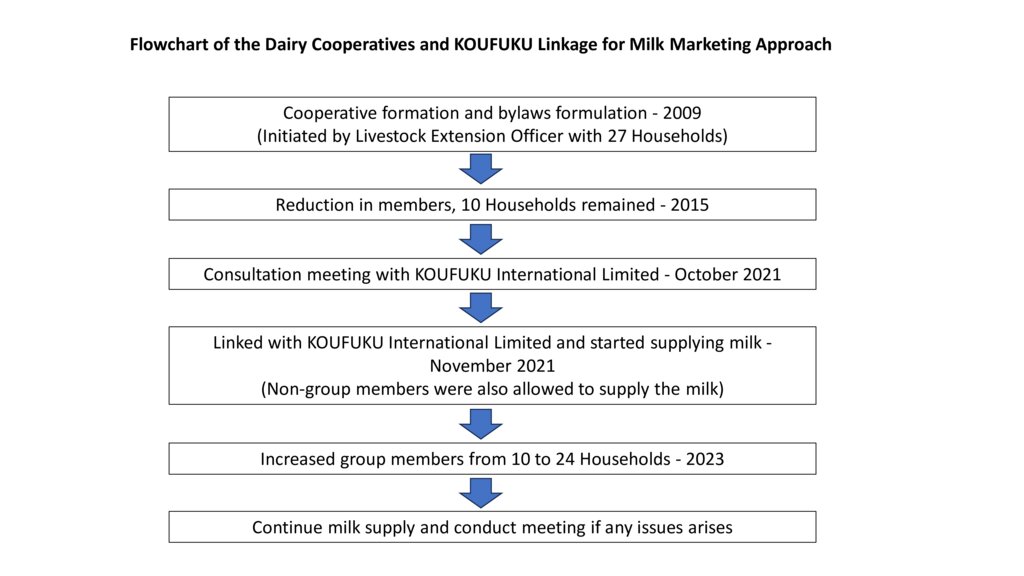Dairy Cooperatives and KOUFUKU linkage for milk marketing [Bhoutan]
- Création :
- Mise à jour :
- Compilateur : Nima Dolma Tamang
- Rédacteur : Haka Drukpa
- Examinateurs : William Critchley, Rima Mekdaschi Studer
approaches_6889 - Bhoutan
Voir les sections
Développer tout Réduire tout1. Informations générales
1.2 Coordonnées des personnes-ressources et des institutions impliquées dans l'évaluation et la documentation de l'Approche
Personne(s) ressource(s) clé(s)
exploitant des terres:
Kelzang
17711512
Tshedung Village, Rizor Chiwog, Udzorong Gewog, Trashigang Dzongkhag
Bhoutan
exploitant des terres:
Tenzin Yeshey
17419479
Tshedung Village, Rizor Chiwog, Udzorong Gewog, Trashigang Dzongkhag
Bhoutan
exploitant des terres:
Karma
77737250
Tshedung Village, Rizor Chiwog, Udzorong Gewog, Trashigang Dzongkhag
Bhoutan
exploitant des terres:
Zangmo Tshering
77201103
Tshedung Village, Rizor Chiwog, Udzorong Gewog, Trashigang Dzongkhag
Bhoutan
exploitant des terres:
Choden Jigme
17725834
Tshedung Village, Rizor Chiwog, Udzorong Gewog, Trashigang Dzongkhag
Bhoutan
Nom du projet qui a facilité la documentation/ l'évaluation de l'Approche (si pertinent)
Strengthening national-level institutional and professional capacities of country Parties towards enhanced UNCCD monitoring and reporting – GEF 7 EA Umbrella II (GEF 7 UNCCD Enabling Activities_Umbrella II)Nom du ou des institutions qui ont facilité la documentation/ l'évaluation de l'Approche (si pertinent)
National Soil Services Centre, Department of Agriculture, Ministry of Agriculture & Livestock (NSSC) - Bhoutan1.3 Conditions relatives à l'utilisation par WOCAT des données documentées
Quand les données ont-elles été compilées (sur le terrain)?
15/07/2023
Le compilateur et la(les) personne(s) ressource(s) acceptent les conditions relatives à l'utilisation par WOCAT des données documentées:
Oui
1.4 Références au(x) questionnaire(s) sur les Technologies de GDT
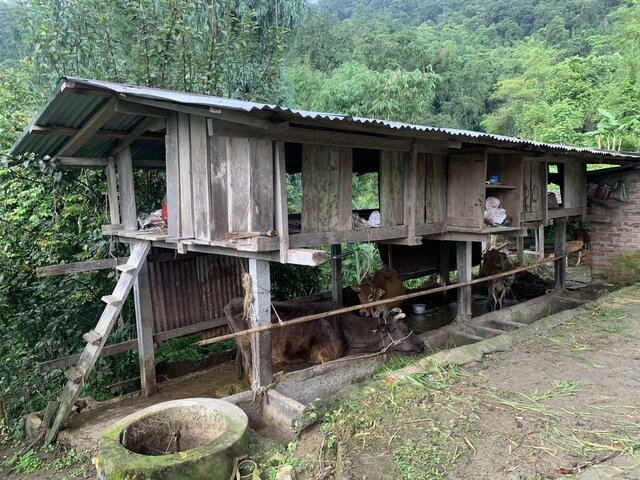
Improved Dairy Shed [Bhoutan]
An improved dairy shed in Bhutan is characterized by concrete floors, cement pillars and troughs, enough sunlight and ventilation, adequate water, ample space for cattle movement, as well as urine and dung collection gutters and a farmyard manure collection area.
- Compilateur : Tshering Yangzom
2. Description de l'Approche de GDT
2.1 Courte description de l'Approche
This approach links dairy cooperatives with a dairy plant, KOUFUKU International Limited (KIL), for milk marketing. It is an established dairy value chain that addresses milk and dairy product marketing issues and improves the livelihoods of many small dairy farmers in eastern Bhutan.
2.2 Description détaillée de l'Approche
Description détaillée de l'Approche:
This approach links dairy cooperatives with a dairy plant, KOUFUKU International Limited (KIL), for milk marketing. It is an established dairy value chain that addresses milk and dairy product marketing issues and improves the livelihoods of many small dairy farmers in eastern Bhutan. The approach encompasses milk cooperatives, collection centres, milk transport vans, and the processing unit operated by KIL. Currently, milk is supplied to the company by approximately 22 milk cooperatives, each consisting of land users engaged in dairy farming. This documentation focuses on the linkage between KIL and one such cooperative named Samphel Chirphen Jersey Detshen of Udzorong Gewog in Trashigang Dzongkhag.
At the heart of the system are collection centres, strategically placed at each dairy cooperative and equipped with chilling machines. Managed by the dairy cooperatives, these centres serve as crucial points for milk collection. A dedicated milk transport van and driver is arranged to facilitate the transportation of milk from individual land users to the collection point, and onward to the processing unit. Designed with insulation, the van ensures the quality of the milk is maintained, preventing deterioration during transit. The pricing structure for land users is influenced by their choice in milk collection and transport: those opting for the company's services receive a lower price per litre.
The KIL processing unit, situated in Chenary, Trashigang Dzongkhag, is a subsidiary of Druk Holding and Investments Limited (DHI). This unit produces a variety of processed milk products, including "Druk Zambala Cheese," salted and non-salted butter, stirred yogurt, gouda cheese, and cottage cheese. This approach improves the livelihoods of land users, encouraging cooperative members to increase milk production which ultimately increases cash income.
For KIL, the company's involvement aims to augment processing capacity. Despite having the potential to process 4000 litres of milk daily, only 44% of this capacity was utilized as of 2021. The approach embraces an inclusive model, involving smallholder land users in cooperative formation and connecting them to the market, making it a successful value chain intervention.
The implementation method of Samphel Chirphen Jersey Detshen employs a consultative approach, engaging various stakeholders such as the Gewog Livestock Extension Officer, Dzongkhag Livestock Officer, CARLEP officials, and a representative from KIL. This collaborative method enables land users to voice their needs, ensuring decisions that benefit the community.
The stages of implementation involve the initiation of cooperative formation driven by awareness created by the Livestock Extension Officer. Group formation facilitates resource-sharing and reduces workload of land user. Further, subsidies and incentives support from the government are directed towards the cooperative rather than individual land users, emphasizing the importance of forming cooperatives to maximize benefits. The dairy cooperative members were supported to construct improved cattle sheds and biogas plants to improved livestock rearing.
Initially, the Samphel Chirphen Jersey Detshen faced marketing challenges, prompting government intervention to connect them with KIL. Consultations resulted in an agreement where land users committed to supplying a minimum of 100 litres per day at a negotiated rate of Nu. 35 per litre, establishing KIL as their end market. Subsequently, improved cattle breeds were acquired, and the cooperatives increased their daily milk supply from 71 to 280-300 litres. Stakeholders, including Gewog Livestock Extension Officer, Dzongkhag Livestock Officer, Gewog Officials, and CARLEP-IFAD, play pivotal roles in providing technical guidance, subsidies, and funding. Regular monitoring ensures the success of the activity.
In summary, this approach benefits land users by enhancing marketing services and providing sustainable sources of household income – and indirectly improves SLM through encouraging better husbandry of dairy cattle and associated biogas plants.
2.3 Photos de l'approche
2.5 Pays/ région/ lieux où l'Approche a été appliquée
Pays:
Bhoutan
Région/ Etat/ Province:
Trashigang Dzongkhag
Autres spécifications du lieu :
Tshedung Village, Rizor Chiwog, Udzorong Gewog
Map
×2.6 Dates de début et de fin de l'Approche
Indiquez l'année de démarrage:
2021
2.7 Type d'Approche
- initiative/ innovation récente locale
2.8 Principaux objectifs de l'Approche
The approach aims to establish an efficient marketing system of the milk by creating a linkage between the land user and the milk processing unit. it will also contriutes to increased in income and improvement of land users' livelihoods.
2.9 Conditions favorisant ou entravant la mise en œuvre de la(des) Technologie(s) appliquée(s) sous l'Approche
normes et valeurs sociales/ culturelles/ religieuses
- favorise
Technologies under the approach such as biogas and improved diary sheds are environment friendly which complements the religious belief of Buddhism through being socially just.
disponibilité/ accès aux ressources et services financiers
- favorise
During the construction of a biogas plant, land users were accessible to the loan from Bhutan Development Bank Limited (BDBL). BDBL focuses on rural prosperity and provides funds for agricultural purposes. Subsidy support is provided by the government.
cadre institutionnel
- favorise
The institutional setting enabled the implementation of technology as there were only a few land users trained for the construction of biogas. The trained land user from the group shared the skills and knowledge with other land users during the installation of the biogas plant.
collaboration/ coordination des acteurs
- favorise
Land users shared ideas, and workloads, and made collective decisions in the meeting to resolve the issues.
connaissances sur la GDT, accès aux supports techniques
- favorise
Implementation of improved cattle sheds and biogas enriched the land user with the knowledge of soil nutrient management. For example, in the past, the land users never collected cow urine due to poor cattle shed design, now they can collect cattle urine and use it as a nitrogen source in vegetable fields.
marchés (pour acheter les intrants, vendre les produits) et prix
- favorise
The linkage reduced the workload of the land users to market the produce as the milk collection was done from the land users' house.
charge de travail, disponibilité de la main-d'œuvre
- favorise
The approach led to reduced workload as each land user need not reach the milk at the collection centre. Further with the cemented cattle shed, maintaining sanitation and cleaning the shed requires less time.
3. Participation et rôles des parties prenantes impliquées dans l'Approche
3.1 Parties prenantes impliquées dans l'Approche et rôles
- exploitants locaux des terres / communautés locales
A total of 34 members (25 male and 9 female), aged between 35 to 50 years old from Samphel Chirphen Jersey Detshen were involved in the approach.
Produce and supply fresh milk to milk processing unit.
Elected members such as Chairman, Secretary and Treasures to function as per bylaws.
- Spécialistes de la GDT/ conseillers agricoles
Gewog Livestock Officer and Dzongkhag Livestock Officer
Provide technical inputs, monitor the activities and progress of the group and take issues that are not resolved within the cooperative to higher forums such as Gewog and Dzongkhag meetings.
- secteur privé
KOUFUKO International Limited
Purchase milk from the land users and provide support in transportation and marketing.
- gouvernement local
Gup, Tshokpa, Mangmi
Monitor group activities and allocate gewog funds if required for the group. For example, the Gewog fund of Nu. 10,00,000/- (Ten hundred thousand) was allocated to purchase improved cattle breeds (jersey) for the land users where a 70% subsidy was provided and only 30% of the total cost was borne by land users.
3.2 Participation des exploitants locaux des terres/ communautés locales aux différentes phases de l'Approche
| Participation des exploitants locaux des terres/ communautés locales | Spécifiez qui était impliqué et décrivez les activités | |
|---|---|---|
| initiation/ motivation | soutien extérieur | Gewog Livestock Extension Officer motivated the land users to form cooperatives by creating awareness of the benefits involved in working in a group rather than individually. |
| planification | interactive | All the stakeholders (Gewog Livestock Extension Officer, Dzongkhag Livestock officer, representatives of the KOFUKU International Limited and CARLEP-IFAD officials) were involved in the planning process. |
| mise en œuvre | interactive | All the stakeholders with related expertise were involved in the implementation process. For example, the Dzongkhag engineer, Gewog Livestock Extension Officer, Dzongkhag Livestock officer, Gup, CARLEP-IFAD officials and land users were involved in the construction of the milk collection shed, |
| suivi/ évaluation | interactive | External monitoring is done by CARLEP-IFAD officials, the Gewog Livestock Extension Officer, Dzongkhag Livestock Officer. Internal monitoring is done by Thrizin to ensure the minimum milk capacity (100 litres) is met. |
3.3 Diagramme/ organigramme (si disponible)
Description:
The flowchart is developed in consultation with the land users.
Auteur:
Nima Dolma Tamang
3.4 Prises de décision pour la sélection de la Technologie/ des Technologies
Indiquez qui a décidé de la sélection de la Technologie/ des Technologies à mettre en œuvre:
- principalement les spécialistes de la GDT, après consultation des exploitants des terres
Expliquez:
Implementation of the biogas plants and improved cattle shed construction was introduced by the Dzongkhag Livestock Officer in consultation with the land users.
Spécifiez sur quelle base ont été prises les décisions:
- expériences et opinions personnelles (non documentées)
4. Soutien technique, renforcement des capacités et gestion des connaissances
4.1 Renforcement des capacités/ formation
Une formation a-t-elle été dispensée aux exploitants des terres/ autres parties prenantes?
Oui
Spécifiez qui a été formé:
- exploitants des terres
Si pertinent, spécifiez le genre, l'âge, le statut, l'ethnie, etc.
There were 34 members in the cooperative consisting of 25 male and 9 female, aged between 35 to 50 years old all belonging to Sharchop ethnicity.
The gender composition is based on the head of the household registered in the census although all the family members (both male and female) are involved in the activity.
Formats de la formation:
- entre agriculteurs (d'exploitants à exploitants)
- zones de démonstration
- cours
Thèmes abordés:
Cattle shed and biogas plant construction and their benefits. Fodder grass plantations such as napier, super napier (Pakchong), and others.
4.2 Service de conseils
Les exploitants des terres ont-ils accès à un service de conseils?
Oui
Spécifiez si le service de conseils est fourni:
- dans les champs des exploitants?
- dans des centres permanents
Décrivez/ commentez:
The Gewog Extension Officer is involved in providing advisory services based on the need.
4.3 Renforcement des institutions (développement organisationnel)
Des institutions ont elles été mises en place ou renforcées par le biais de l'Approche?
- oui, modérément
Spécifiez à quel(s) niveau(x), ces institutions ont été renforcées ou mises en place:
- local
Décrivez l'institution, ses rôles et responsabilités, ses membres, etc.
The institution is strengthened through the approach as there were only 10 members in the cooperative in 2022 which increased to 24 as of 2023.
Précisez le type de soutien:
- renforcement des capacités/ formation
Donnez plus de détails:
Training provided by DLO for biogas construction
4.4 Suivi et évaluation
Le suivi et l'évaluation font ils partie de l'Approche? :
Oui
Commentaires:
External monitoring is done by CARLEP-IFAD officials, the Gewog Livestock Extension Officer, the Dzongkhag Livestock Officer and Gewog Officials. The monitoring officials conduct the site visits to see the implementation of an improved dairy shed, improved cattle breeds, fodder grass plantation and biogas plant. The monitoring is mainly done to meet the objective of the funding agency and service providers i.e. to increase milk productivity and improve the livelihood of the land users.
Si oui, ce document est-il destiné à être utilisé pour le suivi et l'évaluation?
Non
4.5 Recherche
La recherche a-t-elle fait partie intégrante de l’Approche?
Non
5. Financement et soutien matériel externe
5.1 Budget annuel de la composante GDT de l'Approche
Commentez (par ex. principales sources de financement/ principaux bailleurs de fonds):
There is no annual budget allocated for the approach as the linkage is well established. The land users are equipped to sustain themselves. However, if new challenges arise, the budget is sought from various stakeholders.
5.2 Soutiens financiers/ matériels fournis aux exploitants des terres
Les exploitants des terres ont-ils reçu un soutien financier/ matériel pour la mise en œuvre de la Technologie/ des Technologies?
Oui
Si oui, spécifiez le(s) type(s) de soutien, les conditions et les fournisseurs:
1. Financial support
Nu. 11,700/- (USD 140.54) provided for biogas construction for individual households
70% subsidy for procurement of improved cattle breeds
2. Equipment
70% subsidy was provided for the deep fridge for individual household and 3 large for the collection point (30-40 litres) 30% of the amount was paid by land users. Doner funded 100% for the milk collection can, butter churner, and chiller machine.
3. Construction materials per household
Donor funded 100% for the biogas construction materials 8 bags of cement, metal, pipe, stove
Donor funded 100% for the improved cattle shed construction materials 18 bags of cement, 18 number of CGI sheets, half truck sand.
5.3 Subventions pour des intrants spécifiques (incluant la main d'œuvre)
- équipement
| Spécifiez les intrants subventionnés | Dans quelle mesure | Spécifiez les subventions |
|---|---|---|
| machines | entièrement financé | Donor funded 100% for the milk collection can, butter churner, and chiller machine. |
| Deep fridge | en partie financé | 70% by the donor CARLEP and 30% by the land user |
- intrants agricoles
| Spécifiez les intrants subventionnés | Dans quelle mesure | Spécifiez les subventions |
|---|---|---|
| semences | entièrement financé | Fodder seeds were fully financed |
- matériaux de construction
| Spécifiez les intrants subventionnés | Dans quelle mesure | Spécifiez les subventions |
|---|---|---|
| Cement, matal, pipe | entièrement financé | 100% financed for the construction of biogas and cattle shed |
- infrastructures
| Spécifiez les intrants subventionnés | Dans quelle mesure | Spécifiez les subventions |
|---|---|---|
| Cattle shed | entièrement financé | 18 bags of cement, 18 CGI sheet, half truck sand. |
Si la main d'œuvre fournie par les exploitants des terres était un intrant substantiel, elle était:
- volontaire
5.4 Crédits
Des crédits ont-ils été alloués à travers l'Approche pour les activités de GDT?
Oui
Spécifiez les conditions (taux d'intérêts, remboursements, etc.):
Land users in the group can avail loans of up to Nu. 20,000 (USD 240.25) loan payable on quarterly basis for 3 years.
Spécifiez les fournisseurs du crédit:
Bhutan Development Bank Limited - A bank focusing on rural development.
Spécifiez les destinataires du crédit:
Land users
5.5 Autres incitations ou instruments
D'autres incitations ou instruments ont-ils été utilisés pour promouvoir la mise en œuvre des Technologies de GDT?
Non
6. Analyses d'impact et conclusions
6.1 Impacts de l'Approche
Est-ce que l'Approche a autonomisé les exploitants locaux des terres, amélioré la participation des parties prenantes?
- Non
- Oui, un peu
- Oui, modérément
- Oui, beaucoup
The approach improved farm income, knowledge and skills empowering land users to deal with difficult situations efficiently.
Est-ce que l'Approche a permis la prise de décisions fondées sur des données probantes?
- Non
- Oui, un peu
- Oui, modérément
- Oui, beaucoup
Yes, to cite an example, the land users learned that super napier (Napier Pakchong 1 which is a hybrid between Pennisetum purpureum and Pennisetum americanum cv. Pakchong 1) gives more milk than the guatemala. Therefore, they opted for plantation of super napier than guatemala.
Est-ce que l'Approche a aidé les exploitants des terres à mettre en œuvre et entretenir les Technologies de GDT?
- Non
- Oui, un peu
- Oui, modérément
- Oui, beaucoup
Yes, the approach improves market linkage and indirectly encourages land users to increase milk production due to an assured market. The byproduct of the approach (cow dung) can be used to develop farm yard manure (FYM) and biogas plants ultimately improving soil quality, production of alternative energy source for cooking and heating.
Est-ce que l'Approche a mobilisé/ amélioré l'accès aux ressources financières pour la mise en œuvre de la GDT?
- Non
- Oui, un peu
- Oui, modérément
- Oui, beaucoup
The approach enabled stakeholders to mobilize funds and provide subsidies and financial resources to implement SLM. The land users got Nu. 20000/- loan from BDBL to construct improved diary shed.
Est-ce que l'Approche a amélioré les connaissances et les capacités des exploitants des terres pour mettre en œuvre la GDT?
- Non
- Oui, un peu
- Oui, modérément
- Oui, beaucoup
Through the approach, the land users were trained on SLM implementation increasing their knowledge and skills.
Est-ce que l'Approche a amélioré les connaissances et les capacités des autres parties prenantes?
- Non
- Oui, un peu
- Oui, modérément
- Oui, beaucoup
The cooperative is supported by various stakeholders in terms of technical and advisory services. When there is any issues faced by the land users, they turn to the stakeholders for support, where the stakeholders need to develop a method to solve their issues leading to improved knowledge of the stakeholders.
Est-ce que l'Approche a construit/ renforcé les institutions, la collaboration entre parties prenantes?
- Non
- Oui, un peu
- Oui, modérément
- Oui, beaucoup
The approach improved collaboration between stakeholders including CARLEP-IFAD, Gewog and Dzongkhag officials and KOUFUKU International Limited company.
Est-ce que l'Approche a atténué les conflits?
- Non
- Oui, un peu
- Oui, modérément
- Oui, beaucoup
In the past, there were social conflicts in the group as there were a few individuals who failed to do their duty of collecting milk and turning up for other group activities leading to social conflict and misunderstanding. With the establishment of linkage with the processing unit, marketing is facilitated by the company leading to a significant reduction in the social conflict.
The group is equity focused, where economically disadvantaged land users are given priority to join the group. Although milk collection is done from all.
Est-ce que l'Approche a amélioré l'égalité entre hommes et femmes et autonomisé les femmes et les filles?
- Non
- Oui, un peu
- Oui, modérément
- Oui, beaucoup
Any interested land users irrespective of their gender can be part of the cooperative. The greater number of males in the group member list is due to the majority of the men being head of the household. While implementing, both the parties are given equal opportunity.
Est-ce que l'Approche a encouragé les jeunes/ la prochaine génération d'exploitants des terres à s'engager dans la GDT?
- Non
- Oui, un peu
- Oui, modérément
- Oui, beaucoup
Although there are opportunities for the youths to open a large-scale dairy farm with a secured market. There were no interested youth from the community to take up dairy farming. This could be due to better opportunities and facilities available in the town than village setting. However, there were few youth entrepreneurs from the Dzongkhag involved in large-scale dairy farming.
Est-ce que l'Approche a conduit à améliorer la sécurité alimentaire et/ou la nutrition?
- Non
- Oui, un peu
- Oui, modérément
- Oui, beaucoup
The approach provided a sustainable income source increasing the land users' buying capacity for nutritious foods.
Est-ce que l'Approche a amélioré l'accès aux marchés?
- Non
- Oui, un peu
- Oui, modérément
- Oui, beaucoup
There is a significant improvement in the milk market as the buyer comes to the land users' doorstep to collect milk.
Est-ce que l'Approche a conduit à l'utilisation/ sources d'énergie plus durables?
- Non
- Oui, un peu
- Oui, modérément
- Oui, beaucoup
Yes, the approach led to the implementation of biogas technology which is one of the sustainable sources of energy.
Est-ce que l'Approche a conduit à des emplois, des opportunités de revenus?
- Non
- Oui, un peu
- Oui, modérément
- Oui, beaucoup
On average individual household generates Nu. 12000/- by selling milk. Thereby, improving farm income and motivating land users to engage in livestock farming ultimately generating employment.
6.2 Principale motivation des exploitants des terres pour mettre en œuvre la GDT
- augmenter la production
The linkage improved market access to the land users which motivated them to increase production due to an assured market. Implementation of biogas, improved diary shed and FYM improved land users' soil quality and increased crop productivity.
- augmenter la rentabilité/ bénéfice, rapport coûts-bénéfices
The cooperative should supply a minimum of 100 litres of milk to the Company. Therefore, it enabled land users to source support from various stakeholders to increase productivity such as funding for fodder grass slips, subsidy for the purchase of improved breeds of cattle and other supports ultimately leading to increased productivity and profit for the land users.
6.3 Durabilité des activités de l'Approche
Les exploitants des terres peuvent-ils poursuivre ce qui a été mis en œuvre par le biais de l'Approche (sans soutien extérieur)?
- oui
Si oui, décrivez de quelle manière:
Support needed for the establishment of the linkage is completed. Hereafter, the land users can sustain themselves without external support.
6.4 Points forts/ avantages de l'Approche
| Points forts/ avantages/ possibilités du point de vue de l'exploitant des terres |
|---|
| The major strength of the approach is milk marketing where land users get access to the market without having to worry about transportation. On the other hand, KOUFUKU International Limited can increase its production capacity of milk products. |
| Forming a cooperative and working together enabled land users to avail various support from the government as majority of the support is provided to the group than individual households. |
| The approach improved household income leading to improved livelihoods of the land users. |
| Points forts/ avantages/ possibilités du point de vue du compilateur ou d'une autre personne ressource clé |
|---|
| Encourages other land users to form milk cooperatives. Udzorong Gewog is one of the remote areas of Trashigang Dzongkhag and the ability to establish linkage and generate income from livestock farming would encourage other land users from different chiwog and gewogs to form milk cooperatives. This would ultimately improve the living standard of the community and country. |
6.5 Faiblesses/ inconvénients de l'Approche et moyens de les surmonter
| Faiblesses/ inconvénients/ risques du point de vue de l’exploitant des terres | Comment peuvent-ils être surmontés? |
|---|---|
| The land users feel the price for one litre of milk is less (Nu. 35/-) which is barely enough to buy karma feed (formulated cattle feed costing Nu. 1850/- per bag) and mustard cake (Nu. 1900 per bag). The use of fodder grass (pakchong, napier, and guatemala) gives low milk production compared to processed feed. | Sensitize and institute quality based payment for milk, encourage formulation of local feed, and adopt TMR |
| Need for more members in the cooperative to increase the overall productivity. | Sensitize and encourage other farmers to join the cooperative. |
| The spread of cattle diseases such as lumpy skin disease (LSD) leads to the loss of cattle and reduced milk production. | Need for immediate and improved veterinary service in the country. Encourage to put in place biosecurity measures. |
| Faiblesses/ inconvénients/ risques du point de vue du compilateur ou d'une autre personne ressource clé | Comment peuvent-ils être surmontés? |
|---|---|
| The land users are provided with lots of subsidies and inputs making them highly dependent. Which could reduce their capacity to innovate and search for solutions on their own. | Subsidies should be given with conditions. |
7. Références et liens
7.1 Méthodes/ sources d'information
- visites de terrain, enquêtes sur le terrain
Five
- interviews/entretiens avec les exploitants des terres
Five
7.2 Références des publications disponibles
Titre, auteur, année, ISBN:
Norbu. (2021). Linking dairy farmers to koufuko: a case of a successful dairy value chain and marketing in the east. CARLEP. Retrievef from https://carlep.gov.bt/linking-dairy-farmers-to-koufuko-a-case-of-a-successful-dairy-value-chain-and-marketing-in-the-east/
Disponible à partir d'où? Coût?
https://carlep.gov.bt/linking-dairy-farmers-to-koufuko-a-case-of-a-successful-dairy-value-chain-and-marketing-in-the-east/
7.3 Liens vers les informations pertinentes disponibles en ligne
Titre/ description:
Koufuku International Limited
URL:
https://kil.bt/
Titre/ description:
Koufuku International Limited
URL:
https://www.instagram.com/koufukudairy/?hl=en
Liens et modules
Développer tout Réduire toutLiens

Improved Dairy Shed [Bhoutan]
An improved dairy shed in Bhutan is characterized by concrete floors, cement pillars and troughs, enough sunlight and ventilation, adequate water, ample space for cattle movement, as well as urine and dung collection gutters and a farmyard manure collection area.
- Compilateur : Tshering Yangzom
Modules
Aucun module trouvé


